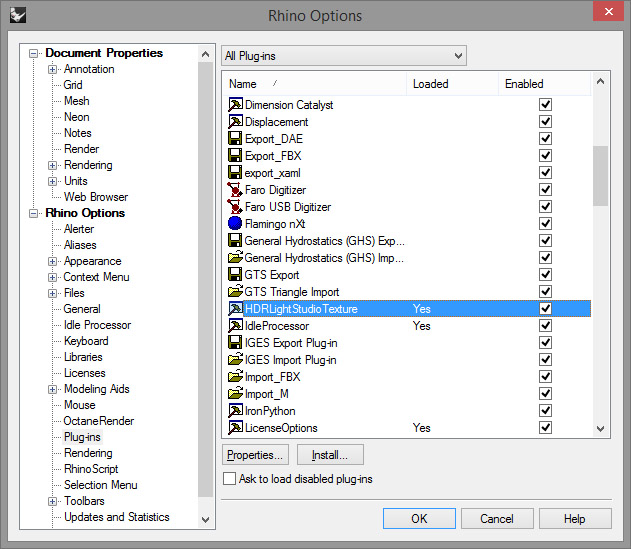
- OCTANE FOR RHINO 6 FOR FREE
- OCTANE FOR RHINO 6 FULL
- OCTANE FOR RHINO 6 PRO
- OCTANE FOR RHINO 6 PROFESSIONAL
Radeon™ ProRender benefits from its simplicity and tight integration with Rhino. Even when the GPU is crunching through a render in Radeon™ ProRender, it will remain snappy and responsive when the designer needs to move the 3D CAD model in the Rhino® viewport. The GPU’s asynchronous compute engine allows compute and graphics tasks to be performed at the same time.
OCTANE FOR RHINO 6 PRO
This problem doesn’t exist when rendering with AMD Radeon™ Pro GPUs. This can make it hard to do any other work on the same workstation until the render has finished. With CPU-based renderers, unless the workstation is manually tuned, and CPU cores are ring fenced, the system can grind to a halt. One of the challenges of ray traced rendering is its large computational demand. This is particularly important when rendering at high resolutions. They not only deliver the computational performance that can render scenes quickly but have plenty of memory to store data for large scenes. One or more AMD Radeon™ Pro WX 7100 (8GB), WX 8200 (8GB) or WX 9100 (16GB) GPUs are good choices for GPU rendering. Unlike most physically-based renderers, which rely on the workstation’s CPU for the complex ray tracing calculations, AMD Radeon™ ProRender is based on OpenCL™, an open standard, so it can use CPUs or GPUs. The AMD Radeon™ Pro WX 8200 is a good choice for Radeon ProRender for Rhino The power of the GPU You can then dive into the options and controls for all aspects of your scene, whether that’s an HDR image for lighting and scene set-up or a ground plane control. To make amendments to your scene, you need to switch to the Render panel on the right-hand side of the Rhino UI and ensure that your ‘current renderer” is set to ProRender. ProRender for Rhino does not currently support additional lighting options, such as spotlights, area lights etc. Third-party HDR image files can also be imported into Rhino. Users can choose from presets, including a Studio environment with soft lighting provided by a high-dynamic range (HDR) image. Radeon™ ProRender for Rhino uses the standard Rhino environment to light the scene. However, it is worth noting that ProRender does not yet support decals inside Rhino. It works without any further modifications, so there is no need to apply additional or replacement materials. Radeon™ ProRender for Rhino automatically uses all of your existing Rhino material definitions and assignments. It’s best to only render one viewport at a time but, with a more powerful GPU, such as the AMD Radeon™ Pro WX 8200, it would be possible to render multiple viewports. You’ll immediately start to see your model resolve into a fully ray traced preview. To preview any of your viewports simply switch the view mode from shaded/wireframe to ProRender. Once you’re happy with the way the scene is setup you can save the view so it can be recalled at any point. The lens length can also be adjusted – a shorter lens to give a wider angle and increase the field of view, a longer lens to give the effect of a telephoto with less perspective. Here users can control viewport size, as well as the camera position and target. This can be done with the mouse or in the Rhino properties panel.

OCTANE FOR RHINO 6 FULL
This means it can be deployed seamlessly throughout the creative process, with users able to flip between shaded, wireframe or rendered modes at the touch of a button, as and when required.Īs everything is done within the familiar Rhino viewport, users have full control when setting up views. Radeon™ ProRender can be used in any of the Rhino viewports. Go to the render pull down menu or the render panel to the right-hand side of the window and change ‘Current Renderer’ to ProRender. To activate the software, simply switch the renderer in Rhino 6.0.
OCTANE FOR RHINO 6 FOR FREE
To install, simply download Radeon™ ProRender for Rhino for free from GitHub. You don’t need to change any of your existing material definitions. And because it is fully integrated with Rhino it allows you to render models directly inside the viewport.

Once installed, it essentially sits alongside the existing rendering engine inside Rhino 6.0.
OCTANE FOR RHINO 6 PROFESSIONAL
Radeon™ ProRender for Rhino is developed by the same team that brings you the professional series of AMD Radeon™ Pro GPUs. But now there’s a new physically-based renderer that can harness the power of either the CPU or the Graphics Processing Unit (GPU). When it comes to photorealistic visualisation, Rhino users have a wealth of options. Radeon™ ProRender can be used in any of the Rhino viewports


 0 kommentar(er)
0 kommentar(er)
